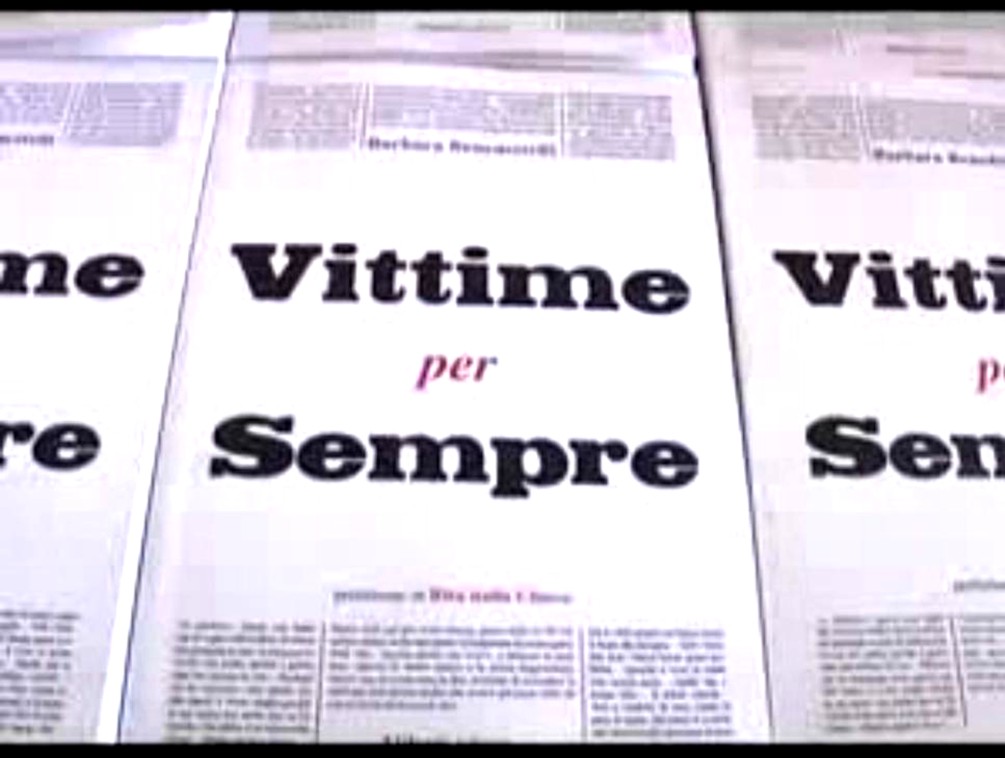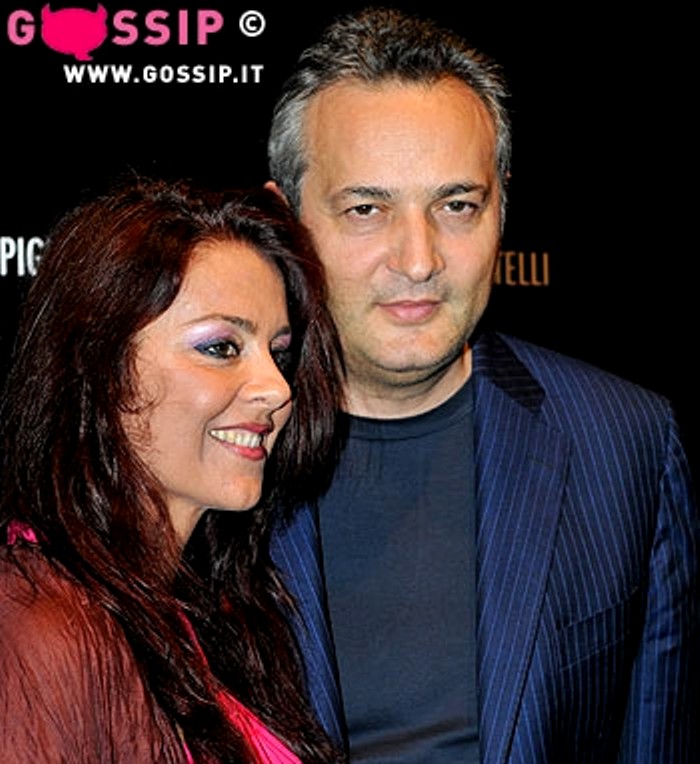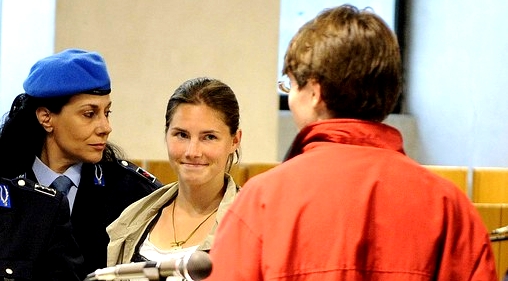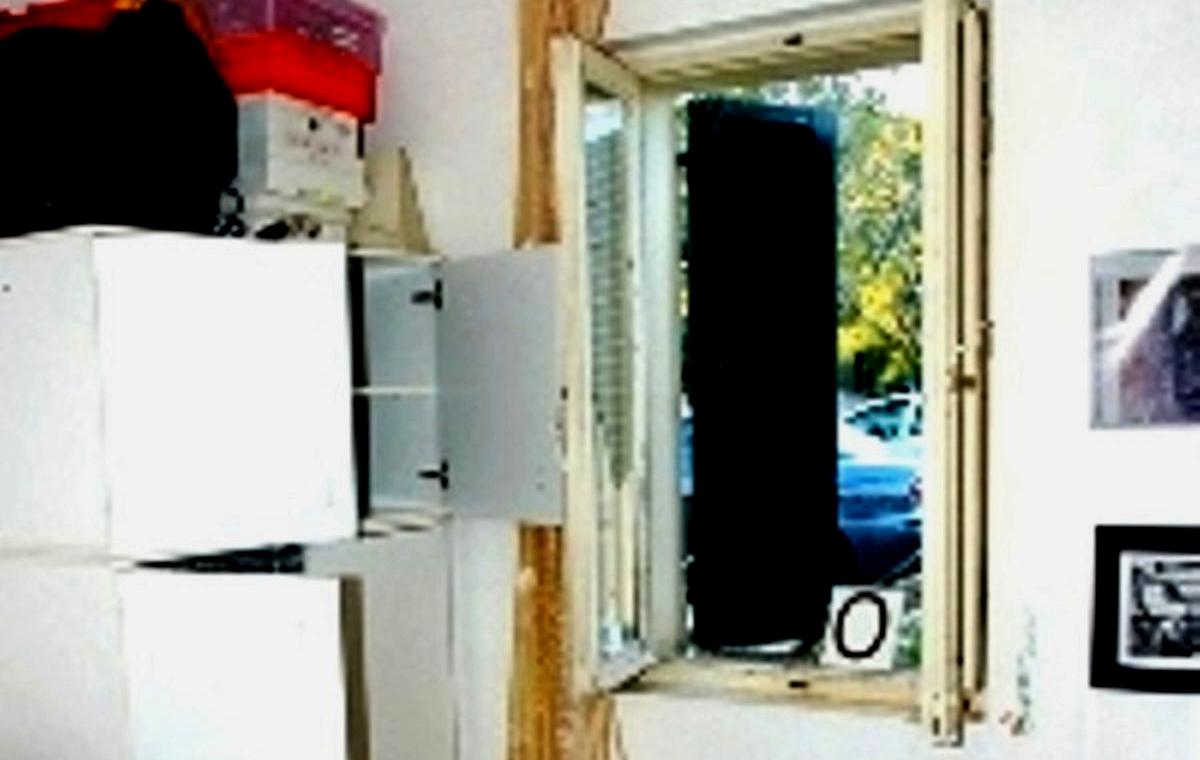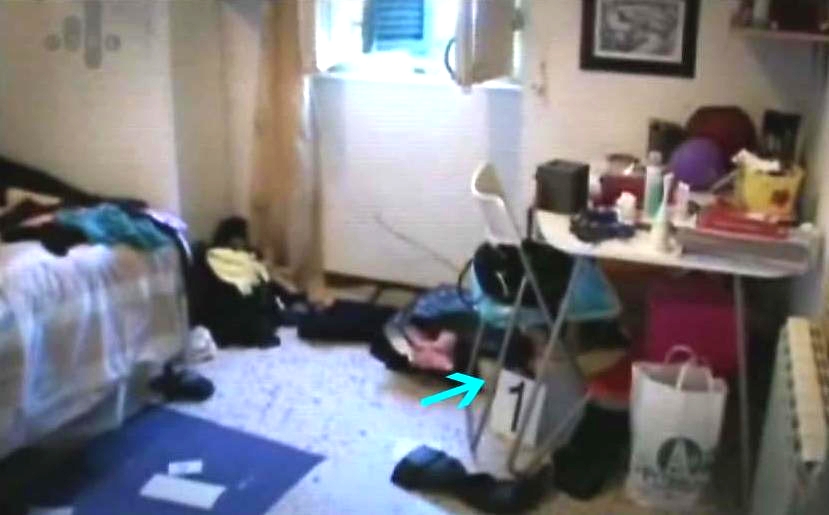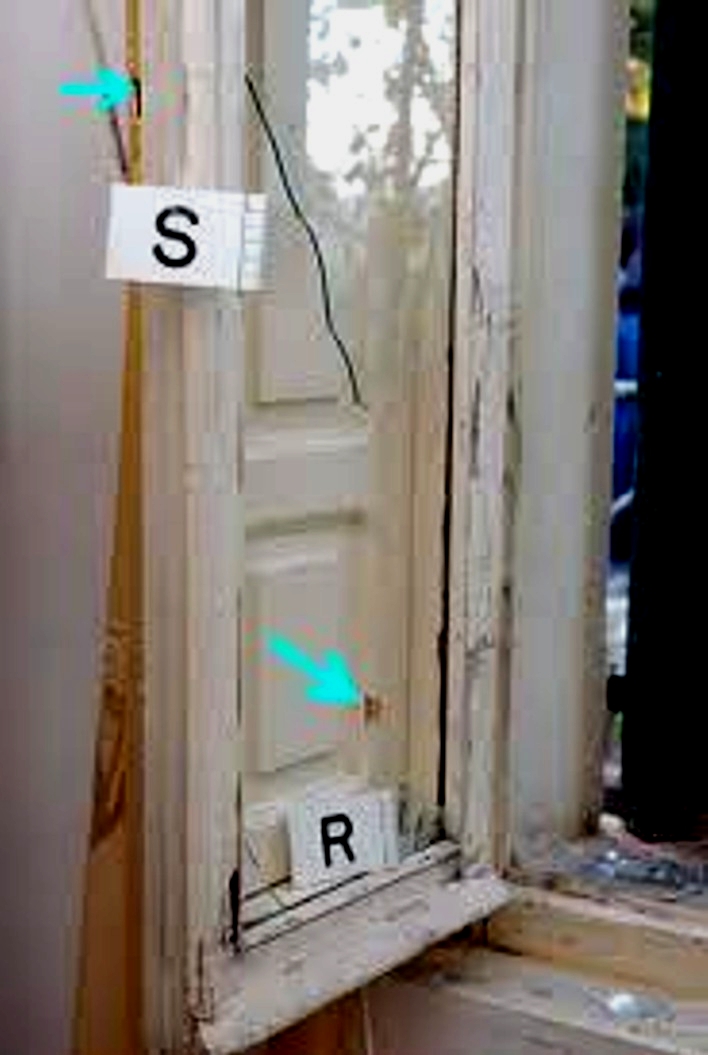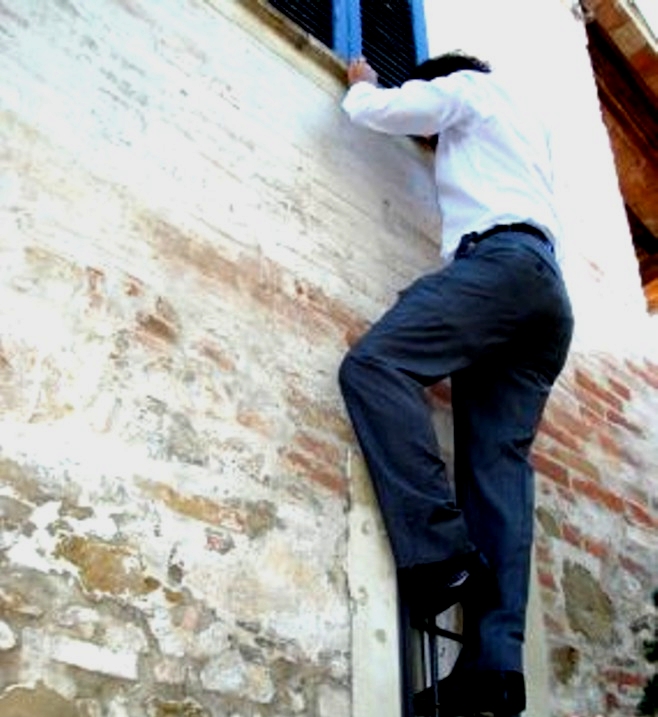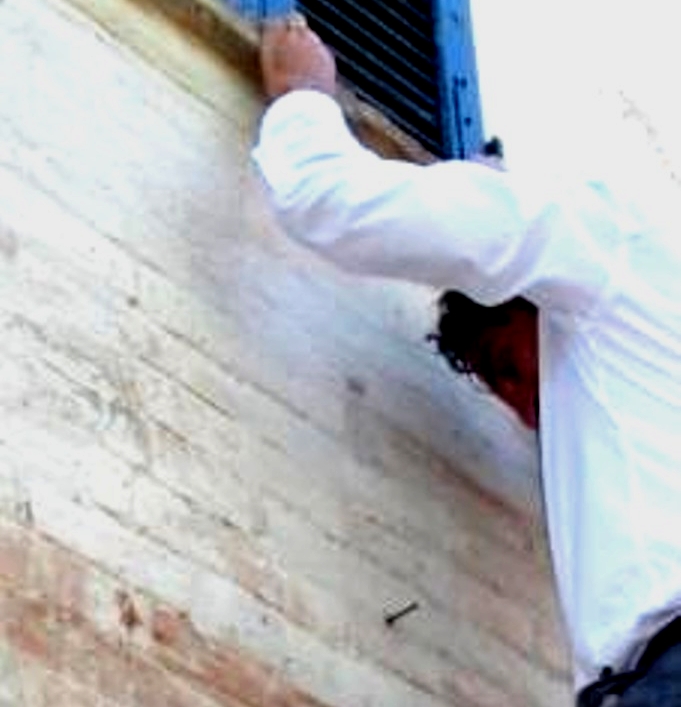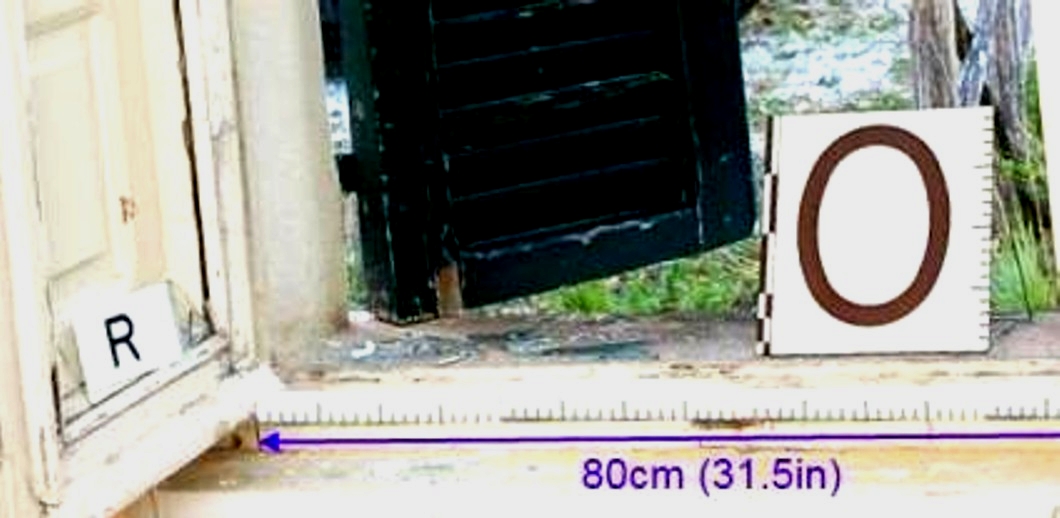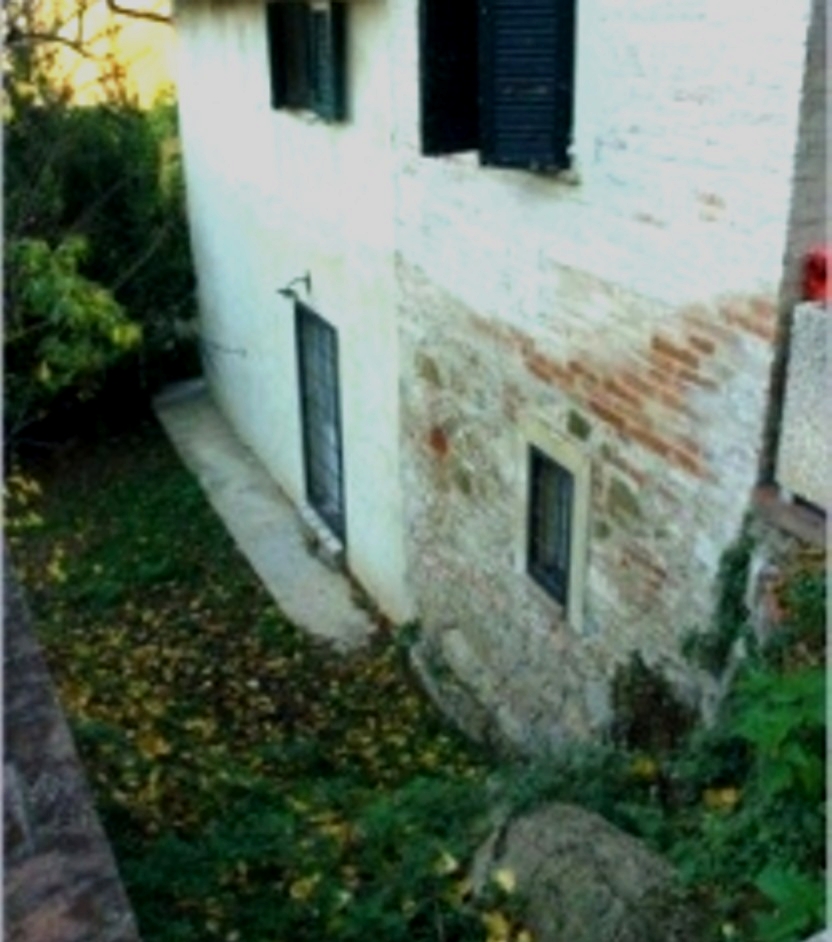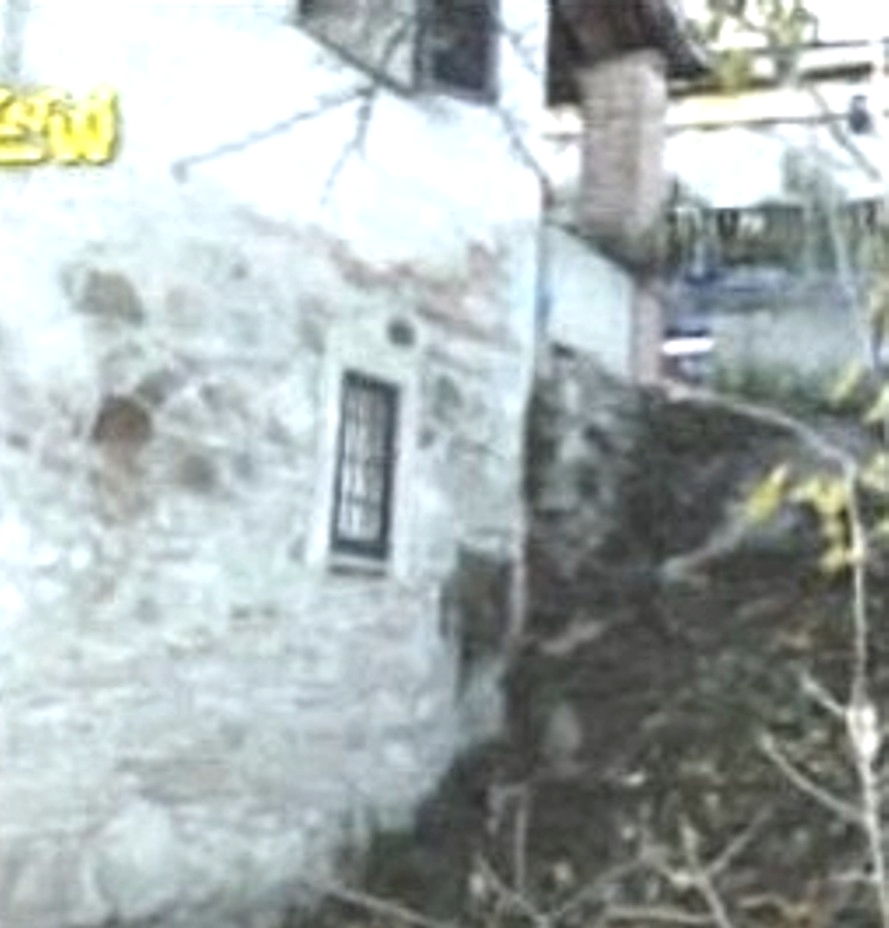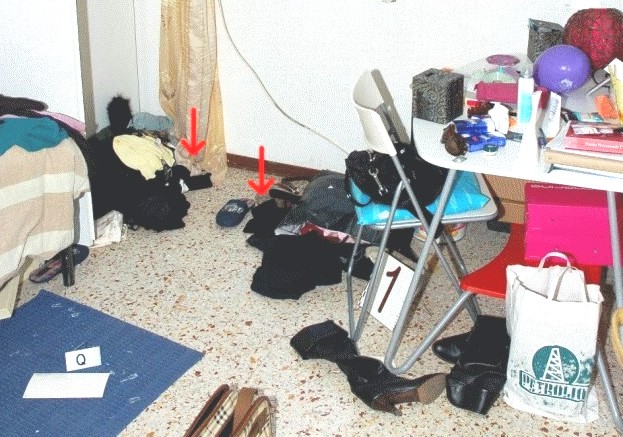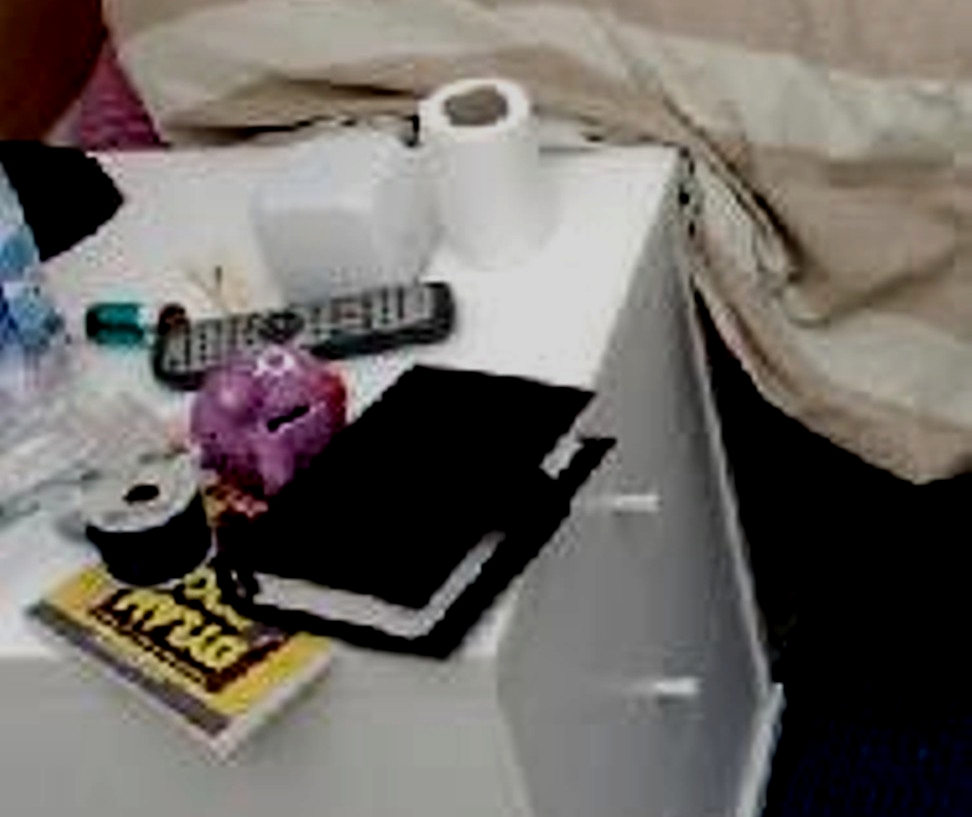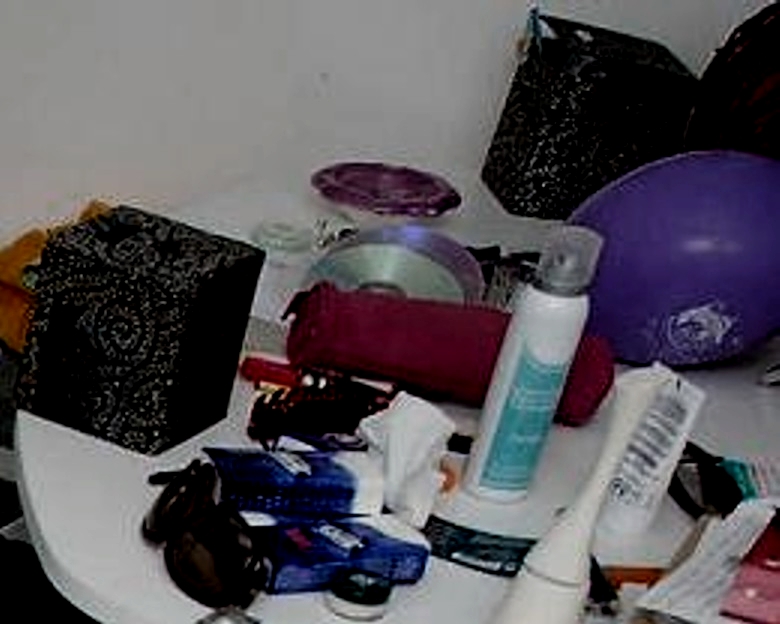
Category: Hoaxes against Italy
Thursday, May 19, 2011
Andrea Vogt Obtains New Rome Embassy Cables From State, Still Showing Zero Concern About Knox
Posted by True North
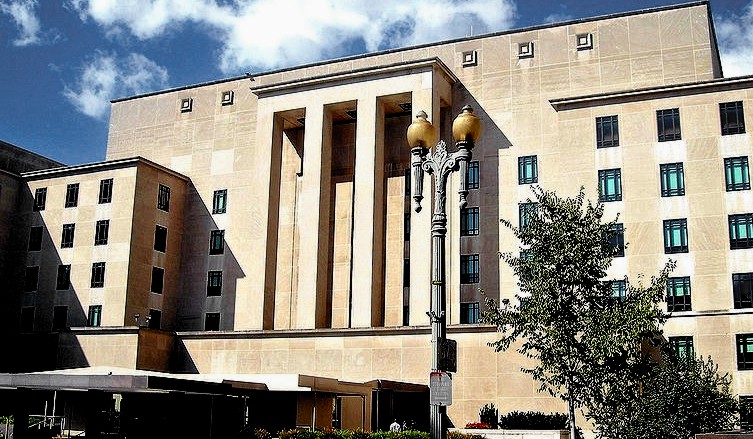
The State Department released seven cables a year ago. Click image above for details of the further release.
They were obtained under the Freedom of Information Act. These now provide a complete overview. The new cables are as bland and routine and unconcerned about Amanda Knox as ever.
There was no smoking gun among them, as the Knox PR campaign had so very much hoped for. The State Department will never move on this case based on how Italy handled it.
Remarkably, the increasingly bitter loser “Bruce Fisher” actually draws attention to the Knox PR campaign’s big disappointing loss with these bland new cables showing Italy has handled the case just fine in the Embassy’s eyes.
The poster of the first seven cables, History Buff, had hoped they would show the Rome Embassy was really concerned about Amanda Knox’s trial and sentence. No such luck. He seems to have hidden those cables now.
You can still read them here
Saturday, April 30, 2011
Barbara Benedettelli: Campaigner For Victims And Families Says Italian System Denies Them Justice
Posted by Peter Quennell
You can see the problem. Many Italians now think that their justice and penal systems lean too far in the direction of perpetrators getting every possible break.
We have posted often on how tough things are for Italian police and prosecutions, and how many hurdles they have to jump through. There is great caution built into the process before cases ever go to trial, and then there are two compulsory rounds of appeal.
There are proportionally very few perpetrators in Italians prison by global standards, and when there in prison they are given quite a nice time, trained to perform usefully when released, and very often get out of prison early.
Seemingly very humane. But this does carry very high costs. There are often almost unbearable pressures on victims’ families, as Meredith’s father John Kercher has several times described. On top of all this, there is the growing western fascination with perps, and in many cases their elevating to popular cult-worship status.
Barbara Benedettelli is a writer and columnist and the editor of the popular “Top Secret” program on Rete4 TV… Her latest book (only in Italian) is called “Victims Forever”. She talks of various prominent perps and the enormous and unrequiting pressures on victims’ families. In polls a large majority of Italians detest this. They want much less stress on “fairness” and MUCH more compassion for victims families and, if still alive, for the victims.
Barbara Benedettelli has been interviewed by Maria Rosaria De Simone for Italia Magazine
Barbara, tell me about your latest book, “Victims Forever.”
In this book, I put all my soul into it. I was completely absorbed, I have worked tirelessly. It’s the outcome of numerous interviews that I made with the relatives of those who were torn from life prematurely. Life is the greatest gift that we possess and it is important that we learn to respect it. We can not devalue it, treat it as waste paper. We can not despise it. Life must be defended. That ‘s what I tried to highlight.
Who are the ‘victims forever’ you speak of?
The victims are always the relatives of those who were killed. Killing a person is to kill an entire world, destroying the lives of family members who are sentenced to a life of pain. The murderer after serving his sentence can still have a future. Relatives of the victims do not.
They are sentenced to a life in pain. In the book I wanted to give voices to these victims. It covers eight stories.
I saw that the book contains interviews with relatives of the victims.
Yes, the book includes dialogues spoken in confidence, and the correspondence I received from relatives who live a life torn apart. They are trying to make their voices heard in order to receive justice, and instead they feel forgotten, mistreated and poorly tolerated by our justice system.
I approached them only to discover a world that I not even remotely imagined. I came into their lives on tiptoe, I saw their pain, the disillusionment of discovering that the murderer, in the process, is transformed from a ruthless criminal into a “poor victim” who is well treated, carefully supported, and spoiled to give him, after a detention not adjusted to the brutality of the crime, a new life, a new possibility for the future and a rehabilitation.
In the Italian criminal justice system, the victims and the relatives of the victims, who have lost their greatest asset, matter very little.
It cares far more for the wellbeing of the murderer, his recovery, his return to the social system. And with this mindset, I found that victims and their relatives do not receive justice.
We have a ‘system of rewards’ and if the murderer demonstrates a desire to involve themselves in re-education, we reduce by forty-five days every six months of the sentence. And we add a number of other benefits.
The book denounces a system that does not respect the victims in their need for recognition of their dignity, their value.
The penalties that are imposed on the offenders should be proportionate to the offense. A man who committed a murder, resulting in a final death, a road of no return, should receive an appropriate sentence, because what he did can not be erased, nor can there ever be reparation.
Instead, our Constitution, with the intent of an educational purpose and the rehabilitation of prisoners into society, has since 1975 triggered a series of benefits for good behavior, leading to numerous reductions of sentences for those convicted.
This is pervasive. It results in assurances for the inmate that leads to a serious imbalance. A murderer is often out of prison very soon, not having fully served his sentence, often emerging unaware of the seriousness of the crime he committed.
Relatives of the victims not only feel that their loved one is killed for the second time by a justice that they consider unjust, but often have to live with the terror of meeting the murderer on the streets of their country, proud and with the eyes of those who got away and without any gesture or sign of repentance.
In my book, the relatives of the victims complained that today in our justice system there does not exist any certainty of punishment.
Can you give some examples?
Take the case of four young boys, Alex Luciani, Daniela Traini, David Corradetti, and Eleonora Allevi. In 2007, they were going to get ice cream.
A Rome boy who was drunk while driving a minibus mowed them down.
Well, consider how much pain, how many people were destroyed that night: the boys, their friends, their parents, their brothers, all those who loved them. Yet all this could all have been avoided. The murderer, Marco Ahmetovic, the previous year had attempted a robbery at a post office. Should he not have been in prison?
Of course, he should have been in prison. And how did it work out?
The taker of four young lives, Ahmetovic, was given six years and six months in prison. He was initially under house arrest in a residence by the sea with a friend, and then released because the house did not meet the standards.
There is no certainty of punishment, as you say. Not only is the sentence not appropriate for the offense that was committed, but even that is not properly served.
Yes, this is an insult to the relatives of the victims. I’ll give you another example. Remember little Tommaso Onofri? [The baby murdered near Parma, Sicily, by Mario Alessi.]
How could I forget? His case has been watched throughout Italy with bated breath ...
I interviewed his mother, Paola. She is a woman destroyed. The closer you get to her, the more you feel her pain and are overwhelmed. Paola calls for justice, justice before any thoughts of re-education, to punish, to emphasize that the life of a child has value.
Destroying that has a price: that of freedom. This price, the price of liberty, must be paid by the murderer. In 2006 Paul had a family and that now no longer exists.
Two men kidnapped Baby Thomas, who was seventeen months old, and they killed him without mercy. Mario Alessi and Salvatore Raimondi, these are the names of the killers.
And Antonella Conserva [Alessi’s wife and] was their alleged accomplice. Alessi was sentenced to life imprisonment. Raimondi, he was given twenty years, he has benefited from the fast-track trial [same as Guede’s] despite the brutality of the crime.
We keep waiting for the decision of the Court of Appeal in Bologna. [The Supreme Court of Cassation referred the wife’s case back to them.] The woman’s defense team seeks to demonstrate that she was not involved despite the evidence.
“I declare myself innocent,” she says. Meanwhile there is only one certainty, that the family will never see again Tommy Onofri that they killed.”
Mario Alessi had already had trouble with the law.
Indeed, this is another important point.
Alessi had a conviction for first and second-degree sexual assault. In 2000 a young couple in their rural home was attacked by two unknown men armed with a gun and a knife. The girl was brutally raped. And the rapist was the very same Alessi, who was arrested but released after only nine months after expiry of the period of detention.
After two convictions for rape, Mario Alessi was turned out and free to go and kill the little Tommaso Onofri.
This is the scandal of the Italian justice ...
Yes, a scandal and you could tell a long sequence of stories like that.
How did you feel to spend so much time with the relatives of the victims?
It ‘s hard. Their pain becomes your own, you’re totally involved.
However there is one thing you can say. Relatives of the victims asked for the certainty of punishment for the murderers through my book, but I have not read in them hatred, resentment and fury. Only pain and grief.
I remember that you entered into politics ...
I went into politics. I was full of projects, I thought I could change the world. I thought I could help those who are weakest, those who are less fortunate.
Unfortunately, I encountered the harsh realities of politics. I found myself alone in my battles. I am too idealistic, I do not go over well with this policy.
And in all this your husband Claudio Brachino [the host of Top Secret, image below] helped you?
Claudio is a wonderful man. Always over the years we worked together. He has always supported me. He’s also a loving father. He respects my work and my need to carry out my work in complete independence.
Claudio is not only a true professional, but he is also very sensitive and is proud of what I’m doing. Even my two sons are, who I love with all my heart, and who I have rather neglected during the writing of this book. Especially in the final stages. I was very busy and unbearable.
*********
Maria Rosaria De Simone adds: I read her book, “Victims forever.” Barbara Benedettelli’s work is valuable not only for the way she conducted the interviews and the reflections of high compassion, but also she uses the Italian language fluently and is full of interesting styles. Very nice also is the foreword to the book by Rita Dalla Chiesa, who recalls the day when she learned of the murder of her father, Carlo Alberto. An excerpt.
This is for More Victims. A book in which the soul of the writer shows through and seems naked, stripped at times. Pages that reflect strong feeling, the passion of civil pain but also the love for life, interspersed with the complaints toward a system that allows double, triple, endless injustices. These make these people, in fact, Victims Still.
Not only once, but whenever a court fails to follow up, a murderer intrudes again in those lives that are torn, injured, deprived of any human right. Every time we, the people, public opinion, politicians, judges, writers, forget that the effect of a murder does not end with the death of a human being irretrievably “deleted”, but continues in those who survive the death. Because a human being is an entire world. A world full of meaning, history, and other people.
Tuesday, April 12, 2011
Explaining The Massei Report: How Motive For The Crime Is Addressed By Judge Massei
Posted by James Raper
The March 2010 Trial Sentencing Report
The Massei Report in the main I thought was excellent. He was incisive with his logic, particularly, though not exclusively, with regard to the staging of the break in and how that necessarily meant that Amanda was present at the scene when the murder was committed.
However, I thought that he was rather feeble in his coverage of the defendants’ motives as to the attack which led to this brutal murder.
Perhaps he thought it better to stick with the indisputable evidence. Since this pointed to a sex attack he surmised that Guede had a go at Meredith first, and then - because the stimulation was too much for them - he was joined by Amanda and Raffaele. This works but does seem a bit weak.
Micheli, the judge who committed Amanda and Raffaele to stand trial, was more certain in his mind as to the roles played by these three. He said that there was “an agreed plan”, “to satisfy sexual instincts” with “murderous intent” and that effectively Amanda was the instigator and catalyst.
Motive is largely an area of speculation but it is surely possible to draw inferences from what we know? As Micheli did. The Appeal Court and ultimately The Supreme Court of Cassation may well adopt the same reasoning and conclusion - maybe go further.
And there were, to my mind, undoubtedly many factors at work, and it is these which I wish to address. I have always been interested in the possible dynamics of just how these three came to murder poor Meredith. Pro-Knox campaigners once made much of “No Motive”. Now not so much, because the issue draws people in to a discussion of the evidence and of Amanda’s personality.
For instance, Massei asks, though he says we can not know, had Amanda egged Guede on as to the “availability” (my word, not his) of Meredith during or prior to their presence at the Cottage?
Frankly the answer to that has to be “yes” since it is a bit difficult to figure out why Amanda and Raffaele would otherwise wish Guede to join them at the cottage. I doubt that Amanda and Raffaele would have wanted Guede around if they were just going there to have an innocent cuddle and sex and to smoke cannabis, as Massei implies. The evidence is that Raffaele hardly knew Guede and in the presence of Amanda was very possessive about her. If he had known of Guede’s interest in Amanda, he would have been even less keen to have Guede around.
Also, if all was so innocent beforehand, then why would Guede have tried it on with Meredith, and then pressed the situation in the face of her refusal to co-operate? Knowing that there were two others there who could have come to her assistance?
The answer is of course that Guede knew full well in advance that there would be no problem with Amanda and Raffaele. He had been invited there, and primed to act precisely in the way he did, at least initially. Why? Well there is plenty of evidence as to why Amanda, in her mind, may have been looking for payback time on Meredith. Come to that later.
What does not get much attention in the Massei Report, other than a terse Not Proven at the end, is the matter of Meredith’s missing rent money and credit cards and whether Amanda and Raffaele stole them. It is as if the Judge (well, the jury, really) felt that this was a trivial issue that brought nothing much to the case, and thus it was not necessary to give it much attention. And indeed there is no summation of or evaluation of that evidence.
Now that does surprise me. Of course there may have been some technical flaw with the charge and the evidence. But in the absence of any comment on this then we do not know what that may be.
What I do know is that the matter, if proven, is not trivial. A theft just prior to the murder significantly ups the stakes for Amanda and Raffaele, and produces a dynamic, which, threaded together with a sexual assault, makes for a far more compelling scenario to murder. It also leads one to conclude that there was a greater degree of premeditation involved: not premeditation as to murder, but as to an assault, rather than the more spontaneous “let’s get involved” at the time of the sex attack as postulated by Massei.
What is the evidence? What evidence was before the court? I do not yet have access to trial records. Therefore I stand to be corrected if I misrepresent the evidence, or if my interpretation of it does not met the test of logic.
There were two lay witnesses to whom we can refer. The first was Filomena Romanelli, the flatmate and trainee lawyer. If there was anyone who was going to ensure that the rent was paid on time, it would have been her. She gave evidence that, the rent being due very soon, she asked Meredith about her contribution of 300 euros, and was told by Meredith that all was OK because she had just withdrawn 200 euros from her bank. Filomena assumed from Meredith’s reply that the balance was already to hand.
Is there a problem with this evidence? Is it hearsay and thus inadmissible under Italian law?
Perhaps it is not enough by itself because of course had Meredith not in fact withdrawn the money from her bank, or sufficient funds to cover the stated amount, then that would be a fatal blow to that part of the theft charge. Her bank manager was summoned to give evidence, essentially to corroborate or disprove Filomena’s testimony. I do not know what exactly that evidence was. One would assume that at the very least it did not disprove her testimony. Had it done so, that would as I have said been fatal. It is also unbelievable that Massei would have overlooked this in the Report. I am assuming that Meredith did not tell a white lie, and that the bank records corroborate this.
There may of course be an issue of timing as I understand that the bank manager told the court that transactions at a cash machine are not necessarily entered on the customer account the same day . However that does not seem to me to be significant.
One must also think that the bank manager was asked what other cash withdrawals had been made if the credit cards were taken at the same time as the money.
I understand that there is of course a caveat here: my assumptions in the absence of knowing exactly what the bank manager’s evidence was.
It would be useful also to know how and when the rent was normally paid. It sounds as if it was cash on the day the landlord came to collect.
We do know that the police did not find any money, or Meredith’s credit cards. Had Meredith, a sensible girl, blown next month’s rent on a Halloween binge? Unlikely. So somebody stole it. And the credit cards? Again, just as with the fake break in, when according to Amanda and Raffaele nothing was stolen, who and only who had access to the cottage to steal the money? Yes, you have guessed it. Amanda, of course.
Does the matter of missing rent money figure anywhere else? There is the evidence of Meredith’s phone records which show that a call was placed to her bank late on the evening of her murder just prior to the arrival of Amanda, Raffaele and Guede. Why? I have to concede that there is no single obvious reason and that it may be more likely than not that the call was entirely unintentional.
But if, as may seem likely, the credit cards were kept with her handbag, and the money in her bedroom drawer, then on discovering that her money was missing she may have called her bank in a funk, only to remember that the cards were safe and that no money could be withdrawn from her account.
The missing money also figured in the separate trial of Guede. He made a statement which formed the whole basis of his defence. Basically this was that he had an appointment with Meredith at the cottage, had consensual foreplay with her, and was on the toilet when he heard the doorbell ring etc, etc. What he also added was that just before all this Meredith was upset because her rent money had disappeared and that they had both searched for it with particular attention to Amanda’s room.
Now why does Guede mention this? Remember this is his defence. Alibi is not quite the right word. He had plenty of time to think about it or something better. His defence was moulded around (apart from lies) (1) facts he knew the police would have, ie no point denying that he was there, or that he had sexual contact with Meredith: his biological traces had been left behind; and (2) facts known to him and not to the police at that stage, ie the money, which he could use to make his statement as a whole more credible, whilst at the same time giving the police a lead. He is shifting the focus, if the police were to follow it up, on to the person he must have been blaming for his predicament, Amanda.
If all three, Amanda, Raffaele and Guede, went to the cottage together, as Massei has it, then Guede learns about the missing rent money, not in the circumstances referred to in his statement, but because Meredith has already discovered the theft, and worked out who has had it, and challenges Amanda over it when the three arrive. Perhaps this is when Guede goes to the toilet and listens to music on his Ipod. After all he is just there for the sex and this is all a distraction.
Although Micheli thought Guede was a liar from start to finish, he did not discount the possibility that Guede was essentially telling the truth about the money. Guede expanded upon this at his appeal, telling the court that Amanda and Meredith had an argument and then a fight over it. It is a thread that runs through all his accounts, from his Skype chat and initial statements in Germany to his final appeal.
Guede’s “evidence” was not a factor in the jury’s consideration at Amanda’s and Raffaele’s trial. Although he was called to give evidence he did not do so. Now his “evidence” and the findings and conclusion of the courts which processed his case come in to play in the appeal of Amanda and Raffaele.
When were the money and credit cards stolen?
I have to accept that, as to the money, at any rate a theft prior to the murder is critical to sustain the following hypothesis. The credit cards were in any event probably taken after the attack on Meredith.
According to Amanda and Raffaele they spent Halloween together at Raffaele’s, and the next day went to the cottage. Meredith was there, as was Filomena. Filomena left first, followed by Meredith to spend the evening with her friends, and Amanda and Raffaele left some time afterwards.
So Amanda and Raffaele could have stolen the money any time after Meredith left and before she returned at about 9.30pm - the day of her murder. Incidentally Filomena testified that Meredith never locked the door to her room except on the occasions she went home to England. Meredith was a very trusting girl.
What motive had Amanda for wanting the money, apart from the obvious one of profit?
There are numerous plausible motives.
To fund a growing drugs habit which she shared with Raffaele? Not an inconsiderable expense for a student. Both Amanda and Raffaele explained during questioning that their confusion and hesitancy was due to the fact that they had been going rather hard on drugs. Mignini says that they were both part of a drugs crowd.
Because her own financial circumstances were deteriorating, and to fund her own rent contribution? She was probably about to be sacked at Le Chic, where she was considered by Lumumba to be flirty and unreliable, and to add insult to injury would likely be replaced by Meredith. In fact Meredith was well liked and trusted by all, whereas Amanda’s star was definitely on the wane.
But maybe Amanda just also wanted to get her own back on Meredith.
Filomena testified that Meredith and Amanda had begun to have issues with each other.
Here are some quotes from from Filomena in “Darkness Descending”.
At first they got on very well. But then things began to take a different course. Amanda never cleaned the house, so we had to institute a rota… then she (Amanda) would bring strangers home… Meredith said she was not interested in boys, she was here to study.
Meredith was too polite to confront Amanda, but she did confide in her pal, Robyn Butterworth. Robyn winced in disbelief when Meredith said that the pair had quarreled, because Knox often failed to flush the toilet, even when menstruating. Filomena began noticing that Amanda could be odd, even mildly anti-social.
It seems that Amanda did not like it when she was not the centre of attention. It was observed that, comically if irritatingly, she would sing loudly if conversation started to pass her by, and when playing her guitar would often strum the same chord over and over again.
On the evening of Halloween, Amanda texted Meredith enquiring as to whether they could meet up. But Meredith had other arrangements. Meredith appeared to be having a good time, whereas Amanda was not.
Indeed there has been much speculation that Amanda has always had deep seated psychological problems and that after just several weeks in Perugia her fragile and damaged ego was tipping towards free fall.
With Meredith’s money, both Amanda and Raffaele could have afforded something a little stronger than the usual smoke, and I speculate that they spent the late afternoon getting stoned.
Of course Amanda was still an employee of Lumumba, and she was supposed to turn up that evening for work, but perhaps she no longer cared all that much for the consequences if she did not.
Again I speculate, that she, with or without Raffaele, met Guede at some time - perhaps before she was due at work, perhaps after she learnt that she was not required by Lumumba - and discussed Meredith’s “availability” and agreed to meet up again on the basketball court at Grimana Square.
The notion that Amanda and Guede hardly knew each other seems implausible to me. We know that they met at a party at the boys’ flat at the cottage. Guede was friends with one of those boys and was invited there on a number of occasions. He was ever-present on the basketball court in Grimana Square, which was located just outside the College Amanda and Meredith attended, and just metres from the cottage. He was known to have fancied Amanda, and Amanda was always aware of male interest.
What else did Amanda and Raffaele have in mind when arranging the meeting or when thinking about it afterwards?
Guede was of course thinking about sex and that Amanda and Raffaele were going to facilitate an encounter with Meredith later that evening. However Amanda and Raffaele had something else on their minds. The logic of their position vis a vis Meredith cannot have escaped them. They had taken her money whilst she was out.
Had she not already discovered this fact then she would in any event be back, notice the money was missing and would put 2 and 2 together. What would happen? Who would she tell? Would she call the police? How are they going to deal with this? Obviously deny it, but logic has its way, and the situation with or without the police being called in would be uncomfortable.
They decided to turn the tables and make staying in Perugia uncomfortable for Meredith? Now the embarrassing, for Meredith, sexual advances from Guede were going to be manipulated by them in to a sexual humiliation for Meredith. Meredith was not going to be seriously harmed, but as and when they were challenged by Meredith over the missing money, as inevitably they would be, she was to be threatened with injury or worse. Knives come in useful here.
Amanda may have fantasized that Meredith would likely then give up her tenancy at the cottage, perhaps leave Italy. Whether that looks like the probable and likely outcome, I leave you to judge, but the hypothesis is that they were starting to think and behave irrationally and that this was exacerbated by the use of drugs.
In the event there came a point when neither Amanda nor Raffaele had any other commitments anyway. They got to the basketball court. They waited for Guede.
We know Amanda and Raffaele were on the basketball court the evening of the 1st November. This is because of the evidence of a Mr Curatolo, the second lay witness. He was not precise about times but thought that they were on the basketball court between 9.30pm and 10pm and may have left around 11.00 - 11.30pm and then returned just before midnight.
In any event he testified to seeing Amanda and Raffaele having heated arguments, and occasionally going to the parapet at the edge of the court to peer over. What were they looking at? Go to the photographs of Perugia on the True Justice for Meredith website, and you will see. From the parapet you get a good view of the iron gates that are the entrance, and the only entrance as I understand it, to the cottage.
So why the behaviour observed by Mr Curatolo? They may have been impatient waiting for Guede to arrive. Were they actually to go through with this? Was Meredith at home, alone, and had she found the money was missing and had she called the police or tipped off someone already? Who was hanging around outside the entrance to the cottage and why?
There was, apparently, a car parked at the entrance, a broken down car nearby with the occupants inside awaiting a rescue truck, and the rescue truck itself, all present around 11.00pm. Amanda and Raffaele did not wish to be observed going through the gates with these potential witnesses around.
We of course cannot know for certain what went on in the minds of Amanda and Raffaele between the time of them leaving the cottage and their departure from the basketball court to return to the cottage. It has to be speculation, but there is a logical consistency to the above narrative if they had stolen Meredith’s money earlier that day, and their meeting up with Guede just before leaving the basketball court does not look like a coincidence.
From there on in to the inevitable clash between Amanda and Meredith over the money.
It is my opinion that at the cottage Amanda came off worse initially: that she got caught in the face by a blow and suffered a nose bleed.
Experts Stefanoni and Garofano both say that there was an abundant amount (relatively speaking) of Amanda’s blood in the bathroom washbasin, and to a lesser extent the bidet. Whereas most of Amanda’s blood in the bathroom was mixed with Meredith’s, the blood on the washbasin tap was Amanda’s alone. Both of a quality and quantity to discount menstrual (from washed knickers) or bleeding from ear-piercing. Their conclusion was that Amanda bled fairly profusely though perhaps briefly at some stage.
Possibly Amanda may have cut her feet on glass in Filomena’s bedroom but if so it’s difficult to see how blood from that ends up as a blob on the basin tap and in the sink, and cut feet are painful to walk on and she did not display any awkwardness on her feet the next day.
Amanda’s blood may have come from a nick by a blade to her hands. I think the nick would be obvious the next day. If so, she was not hiding it. She was photographed the next day outside the cottage waving her hands under the noses of a coterie of vigilant cops.
She might have got a bloody nose during the attack in Meredith’s bedroom save that there is no evidence of her blood there.
On the other hand if she got into a tussle with Meredith (say in the corridor outside their rooms and where there was little room for other than the two to be engaged) and was fended off with a reflex blow that accidentally or otherwise connected with her nose, Amanda’s natural reaction would be to disengage immediately and head for the bathroom sink to staunch the flow of blood.
A nose-bleed need not take too long to staunch, especially if not serious and if there is no cut (certainly none being visible the next day). Just stuff some tissue up the offending nostril. A nose bleed is not necessarily something of which there would be any sign the next day.
Raffaele fusses around her, whilst Rudy briefly plays peacemaker. But Amanda is boiling. As furious with Raffaele and Guede as she is with Meredith. She eggs Guede on and pushes him towards Meredith. Raffaele proudly produces his flicknife, latent sadistic instincts surfacing.
Is a scene like this played out inside the cottage or outside? I think of the strange but sadly discredited tale told by Kokomani.
In any event motive is satiated and the coil, having been tensed, is sprung for the pre-planned, but now extremely violent, hazing of poor Meredith.
I am also thinking here of Mignini’s “crescendo of violence” and where a point is reached where anything goes ““ where there is (from their warped perspectives) almost an inevitability or justification for their behaviour. A “Meredith definitely needs teaching a lesson now!” attitude.
Psychology is part of motive and there is much speculation particularly with regard to Amanda and Raffaele. They have both been in prison for well over three years now and during this time psychological assessments will certainly have been carried out.
Based on specific incidents and and general patterns of behaviour, speech and language, and demeanour, some preliminary conclusions will have been reached correlated with the facts of the crime.
If their convictions are upheld, these assessments may be relevant to sentence insofar as they shed light on mitigation and motive.
Thursday, March 10, 2011
Giuliano Mignini’s Trumped-Up Conviction For Guessing Right In The MOF Case
Posted by TomM

We previously posted on the case here and here and here.
Giuliano Mignini became involved in the Monster of Florence case only years after many people had already come to believe a satanic sect in Florence might be behind the MOF murders. But he pursued it with a vengeance when a body that in 1985 mysteriously washed up on the shore of a lake in his jurisdiction showed signs of murder.
And when the crime fiction writer Doug Preston injected himself into the case under a pseudonym and appeared to be planting evidence, Mignini gave him a very brief shaking up and Preston timidly removed himself from the case and from Italy - to turn to inventing a whole lot of fiction about it from safely across the Atlantic.
Here now is the fine Italian journalist Adriano Lorenzoni, describing The Strange Conviction of PM Giuliano Mignini by the prosecutor whose frustrated conversation was captured (the recording seemed to prove there was indeed a satanic sect in Florence) in objective terms that prove sympathetic to Mr Mignini.
Translation here is with the kind help of my fellow poster Clander.
The Perugian investigation of the instigators of the crimes of the Monster of Florence has, in effect, been stopped.
In January of 2010 the Public Prosecutor of Perugia, Giuliano Mignini, and the former head of the flying squad of Florence, Michele Giuttari, were sentenced by the Court of Florence on the charge of abuse of office in an investigation into some Perugians connected to the “instigators” of the crimes of the Monster of Florence. According to the prosecution’s theory, Mignini and Giuttari illegally wiretapped and investigated journalists and law enforcement officials to influence their activities.
These are abnormal proceedings, since the Public Prosecutor Mignini had been properly authorized by the Investigating Magistrate of Perugia to use wiretaps for his investigation, actions that he had the duty to carry out. Abnormal proceedings also because leading the investigation against Mignini and Giuttari was the same Public Prosecutor’s Office [Procura] that Mignini [PM di Perugia], had investigated the head of, Ubaldo Nanucci. Not by chance did Dr Mignini object to the jurisdiction of that Office [Procura] to carry out the investigation and raise objections of the legitimacy of the judgment. The Court of Appeal of Florence will hear the appeal next November 22 [2011].
This all springs from a recording made by Michele Giuttari of one of his conversations with a Deputy Prosecutor of Florence, Paolo Canessa, in which Canessa states that his boss was not a free man and admits to having been hindered by the then Prosecutor General, Ubaldo Nannucci, regarding the requests of Dr Giuttari into the investigation of the crimes of the Monster of Florence.
Giuttari [then] sent the recording to Mignini, who turned it over to the Prosecutor’s Office of Genoa which had been authorized to investigate the magistrates of Florence. Prosecutor Nannucci was then investigated [verrà inquisito] for having slowed down, or rather obstructed, the investigation of the Monster of Florence. Genoa promptly dismissed [archivierà ] it.
Giuttari continued to complain to Mignini about the conduct of the police commissioner of Florence, De Donno who, as ordered by the Ministry of Internal Affairs, should have set up a new wire tapping room for the GIDES (serial crimes investigative unit) where Giuttari and his men were working [si erano sistemati]. De Donno never set up the new room [cosa che non fa]. Mignini charged him and sent the file to Florence.
A question comes to mind: where is the abuse of office in all of this?
It is also puzzling why there was such an apparent lack of interest in the investigations conducted by Michele Giuttari, even when they are not being obstructed. “The instigators must not be investigated because there are only conjectures, a fruitless waste of time,” Giuttari is told.
Astonishing. As long as the [lowlife] “snack buddies” are being investigated [for the MOF , all is well. It’s fine to investigate Pacciani, Lotti and Vanni; but when the investigation tries to produce greater results [si alza il tiro], problems start to arise. Michele Giuttari was even relieved of his post and transferred.
Prosecutor Mignini’s office is searched and documents from an ongoing investigation into the death of the Perugian doctor Fransesco Narducci are seized, documents which Mignini had without success objected were secret.
Another question comes to mind: why so much fear (in Florence and in Perugia) about the investigation of the death of Francesco Narducci?
According to the Perugian Public Prosecutor [Mignini], Francesco Narducci was connected in some way to the Monster of Florence case. Giancarlo Lotti, one of the [lowlife] snack buddies, asserted that some doctor was given the amputated parts of a female body, in exchange for money.
Crimes, therefore, on commission [i.e. murder or mayhem for hire] by a doctor. A real doctor, not the mere pharmacist, Francesco Calamandrei, of San Casciano val di Pesa. Among other things, during the investigation it emerged that Calamandrei and Narducci knew one another. Narducci then died in unclear circumstances on October 13, 1985. Drowned in the waters of Lake Trasimeno. One month after the last murder committed by the Monster of Florence.
Suicide was claimed at that time. A truth considerably less than believable. So much so that while the Preliminary Investigations Judge [GIP], Marina De Robertis, dismissed the case for lack of enough evidence [con formula dubitativa] the hypothetical murder case against certain suspects (the journalist Mario Spezi, the pharmacist from San Casciano, Calamandrei, and others) and declared it time-barred, still, evidence exists of other crimes committed at the time: the concealment and abduction of a corpse and the falsification of numerous public records.
Moreover, since last April, we have been waiting to learn the reasoning with which, for different reasons, including claimed lack of evidence, the Preliminary Hearing Judge, Paolo Micheli, acquitted twenty people (including Narducci’s father and brother) of charges of forgery, criminal conspiracy, dereliction of duty, and concealment of a corpse.
Against this decision of the Preliminary Hearing Judge, Public Prosecutor Mignini will most likely file an appeal as soon as the sentencing reports are lodged which should have been lodged last July 20 [2010].
Mignini and Giutarri were acquitted of the charges of abuse of office (and Mignini also of aiding and abetting Giuttari) because it was not proven that any crimes were committed [i fatti non sussistono] (and the Florence Prosecutor’s Office did not appeal).
[The abuse of office charges] related to their so-called parallel investigations to those of the Genoa Prosecutor’s Office, which was investigating the former head of the flying squad of Florence for false acts [falso] due to the recording of the conversation with the deputy [Prosecutor] Canessa (of which we have spoken above) which, according to the indictment, had been tampered with. This investigation then led to the search of the office of the Public Prosecutor of Perugia [Mignini’s office] and the seizure of numerous investigation documents.
Needless to add that the proceedings against Giuttari and the two police officers concluded with a judgment of non-suit for absolute lack of foundation of fact, as proclaimed by the Genoan Preliminary Hearing Judge Roberto Fenizia. The “aberrant” conviction of Giuliano Mignini does not have immediate disciplinary consequences of any kind. The disciplinary proceeding is in fact suspended until the resolution of the criminal case on which it depends.
And Public Prosecutor Mignini is able to continue to carry out his functions, in trials of great importance and of international interest, such as that relating to the death of the English student, Meredith Kercher.
Thursday, March 03, 2011
The DEFENSE Not Italian Officials Leaked About Knox HIV Test In Capanne DRAFT
Posted by Michael
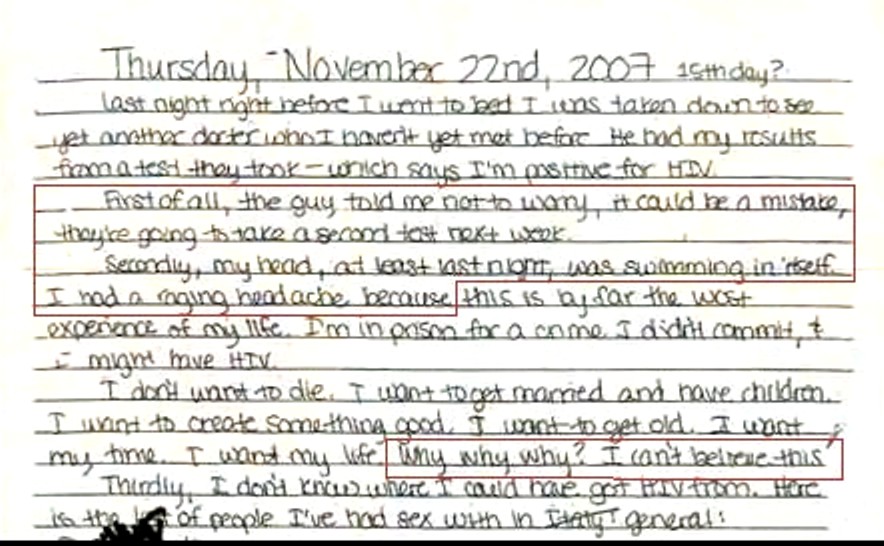
The several wrong facts in the Lifetime movie, especially of timeline, perhaps balanced one another out, and seemed to leave many viewers sensing the possibility of guilt.
However, there was one very serious wrong claim in the movie and in the following documentary which implied criminal action on the part of the Capanne Prison medical staff and prosecutors and may have aroused a lot of false sympathy for Amanda Knox.
The film depicted Amanda knox being told by the doctor at Capanne that in a routine test she tested positive for HIV and to write down a list of her previous partners. Later, a confrontation was shown between an angry Amanda and the doctor (which never happened) when he told her she was all clear.
In reality, the doctor told Amanda at the start that the test was probably a false positive and that she shouldn’t worry and that another test would be run. The doctor never instructed Amanda to write out a list of her previous partners. And the prosecutors never leaked that list.
In Amanda Knox’s own words, you can read above how it went down: She chose herself to create the sex partners list.
The myth in the movie of how the sex partners list was created and spread around was then later compounded by the ‘Knox friendly’ Lifetime documentary. That also claimed Amanda Knox was told to write down her list of partners by the doctor and then her diary was leaked by prosecutors to the public.
We know this to be false. We know that it was instead Amanda Knox’s own lawyers that leaked the diary with the sex partners list (to journalists like Barbie Nadeau) and the family effort that leaked it to people like Frank Sfarszo (who duly published Amanda’s diary page on previous sexual partners), and Candace Dempsey, and even tried to leak it to us!
Amanda’ Knoxs family know the truth of this, but have not yet come out and corrected a seriously wrong pervasive impression. And Lifetime repeated the lie of the sex partners list, leading millions to believe the ILE deliberately terrified, tricked and humiliated Amanda Knox.
But they didn’t. Amanda Knox herself showed it was not so.
Lifetime’s Misleading Portrayal Of Knox HIV Leak: One Of Many Dishonest Knox-Team Leaks
Posted by Michael
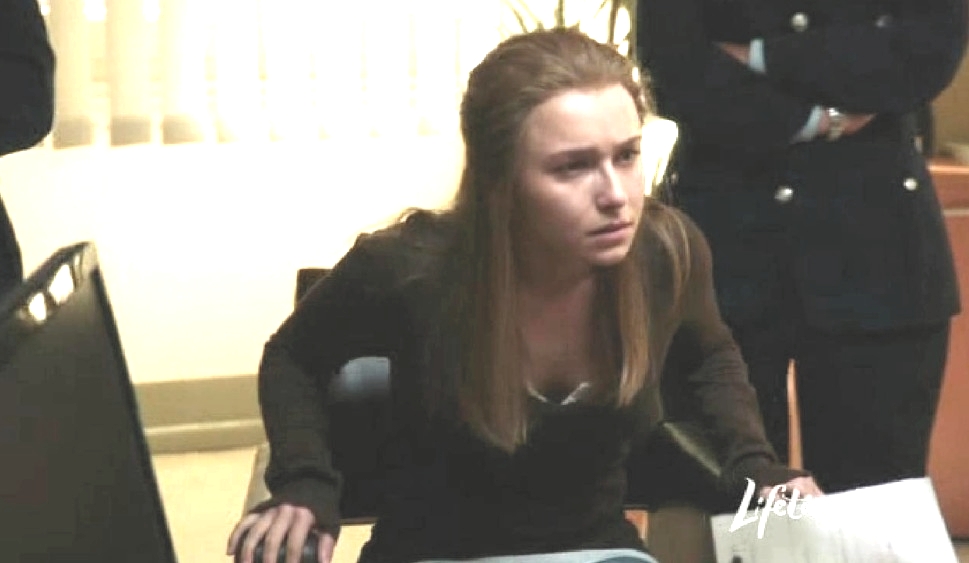
Above and below: images from the two misleading scenes
1. Movie Advances HIV & Sex Partners List Hoax
The Lifetime movie nicely depicted Meredith and Dr Mignini, and was not tough on Knox, though it seemed to leave many viewers sensing the possibility of guilt.
However, there were several seriously wrong scenes in the Lifetime movie, and also in the associated Lifetime documentary. Two scenes advanced the HIV-test and sex-partners-list hoax.
- 1. In a first long and emotional scene, the film depicted Amanda Knox being told by the doctor at Capanne that in a routine test she tested positive for HIV. It implied the test was a form of pressure. It showed Knox being told she should write down a list of her previous partners.
2. In a second long and emotional scene, the film depicted a confrontation between an angry Amanda and the doctor when he told her she was all clear. And thereafter depicted that it was the the prosecution that leaked the sex partners list.
These implied criminal actions on the part of both the Capanne Prison medical staff and the prosecutors, and aroused a lot of false sympathy for Knox.
2. The Hard Facts About Knox’s HIV Testing
1. Lifetime V Reality: Knox Had Herpes When She Was Tested
Lifetime simply depicted Amanda Knox being told by the doctor at Capanne that she tested positive for HIV. It implied the test was unusual.
In fact, on her admittance to Capanne Prison, Knox was simply routinely tested for HIV and some other possible conditions, as all prisoners are, for their own good.
Knox had herpes at the time, visible on her lip in many photographs, and herpes can result in a false positive result for HIV.
2. Lifetime V Reality: Proof Knox Warned Positive Test Maybe False
Lifetime did not depict Knox being warned about false positives. But Knox’s diary reads:
Last night before I went to bed I was taken down to see yet another doctor who I haven’t yet met before. He had my results from a test they took which says I’m positive for HIV.
First of all the guy told me not to worry, it could be a mistake, they’re going to take a second test next week….
3. Lifetime V Reality: Knox Herself Creates Sex Partners List
Lifetime claimed Amanda Knox was told to write down her list of partners by the doctor.
But in Amanda Knox’s own words, you can read how it went down: She chose herself to create the sex partners list. The doctor never instructed Amanda to write out that list. Her diary reads:
Thirdly, I don’t know where I could have got HIV from. Here is the list of people I’ve had sex with in Italy [strike Italy] general:...
4. Lifetime V Reality: There Was No Angry Confrontation
Lifetime depicts a yelling, pointing Knox, who has to be restrained.
The doctor merely conveyed the news of a negative results and Knox cheerfully went off. He had no ill intent, she did not get angry, and no accusations were made.
3. The Hard Facts About Who Leaked The Results & List
Lifetime implied that Knox’s diary with the list of partners was leaked by the prosecutors to the public.
We know this to be false. We know that it was instead Amanda Knox’s own lawyers that leaked the diary with the sex partners list (to journalists like Barbie Nadeau). And that the family effort leaked it to people like Frank Sforza (who duly published Amanda’s diary page on the previous sexual partners), and Candace Dempsey, and even tried to leak it to us!
Amanda’s lawyers leak like sieves, always have, and they’ve rarely, if ever, asked Amanda permission to do so. It isn’t actually required, since she’s already given them permission to act on her behalf. In a way, it’s a bit like electing a politician. Once you’ve elected them, they don’t have to come back to you (the electorate) for permission every time they want to pass a bill, create a new policy or enter into negotiations.
When we had our own reporter (Stewart Home) attending the trial, the defence happily showed him anything in the case file he asked to see. In fact, many times they offered without his having to even ask.
In addition, Amanda’s family have been doing quite a lot of ‘leaking’ themselves. Frank Sforza and Candace Dempsey got most of their data from them, as did Charlie Wilkes, Mark Waterbury and Bruce Fischer. And this leaking by the family started long before the trial.
It needs to also be pointed out, Sollecito’s family and lawyers have also been doing their share of leaking.
However, the Knox family and their followers have been only too happy to publicly blame all this leaking on Italian law enforcement (ILE) and cite this as another injustice against their daughter. The US media have been only too happy to carry these accusations, without question. This is how the ILE have been framed and it stinks.
4. Relevant Misleading Scenes In The Lifetime Film
Top and below: the first partly imaginary scene
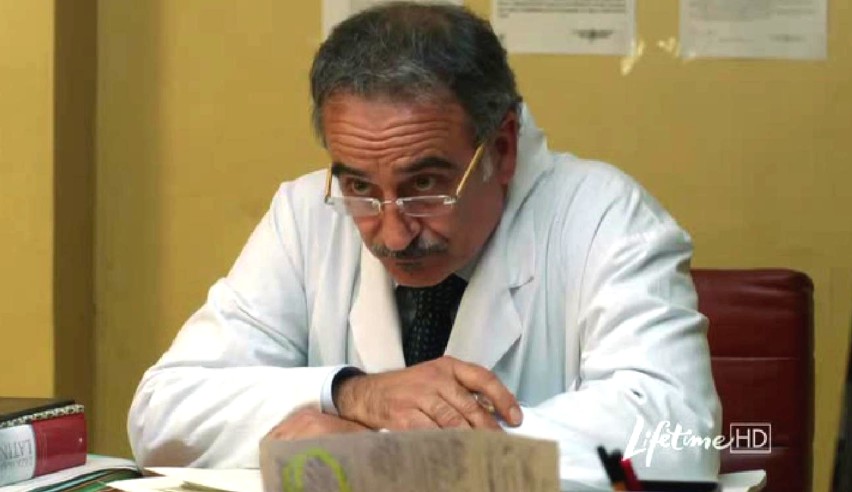
Above and below: the first partly imaginary scene
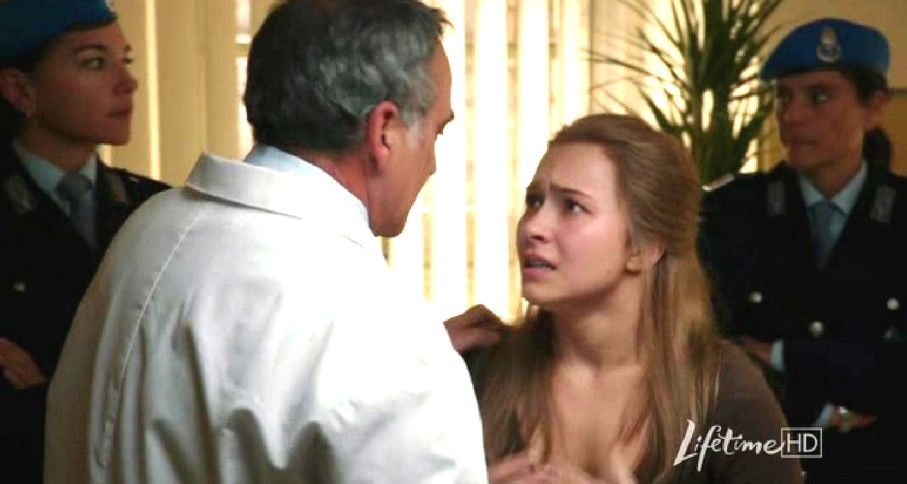
Below: the second very misleading scene
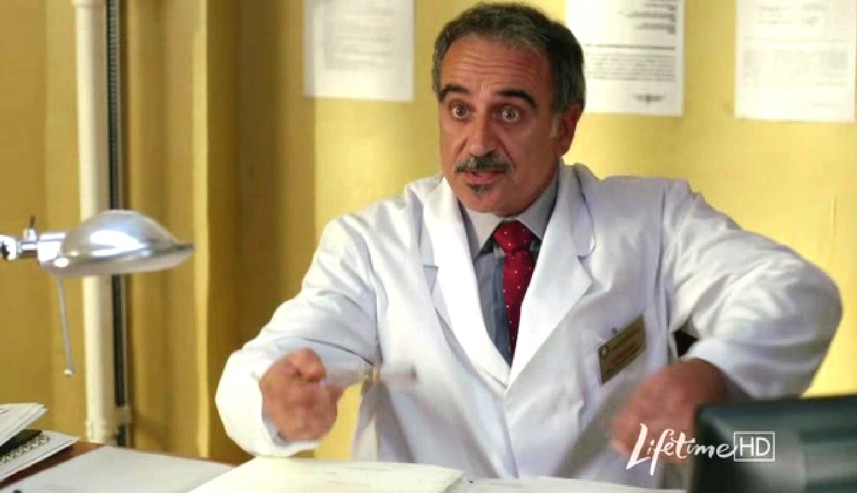
Below: the second very misleading scene
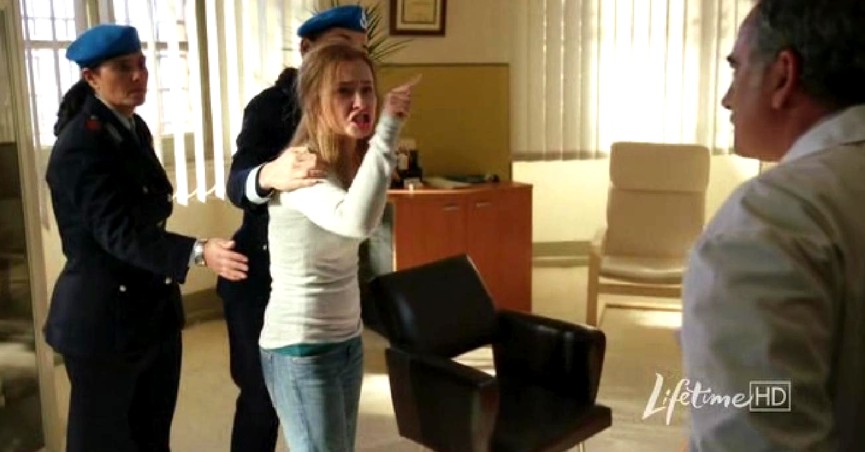
5. Bottom Line: One Of Many Knox-Team Hoaxes
Amanda’ Knoxs family know the truth of this, but have not yet come out and corrected a seriously wrong pervasive impression.
And Lifetime repeated the lie of the sex partners list, leading millions to believe the ILE deliberately terrified, tricked and humiliated Amanda Knox.
Saturday, February 26, 2011
Very Hard Language Of Supreme Court In Rejecting Guede Appeal, Confirming Three Did It
Posted by Peter Quennell
The report of the Supreme Court of Cassation released on Thursday was foreshadowed in content in our post of 17 December:
Rudy Guede’s appeal is rejected on all ten grounds. His appeal grounds were ugly and dishonest and he has no further appeal. He will serve his 16 years, with maybe some time off, for being a savage willing party to the cruel stupid murder of Meredith.
Rudy Guede will go down in infamy for his sex crime against a defenseless victim, for being a party to a taunting torturing knife attack, for claiming Meredith invited him in for consensual sex, and for not calling for help for Meredith and maybe saving her life while it was still possible.
Cassation continues the fine Italian court tradition in this case of taking a firm and unblinking position, and for being utterly oblivious to the vile over-the-top campaign of Curt Knox, Edda Mellas and David Marriott which may now haunt Amanda Knox all of her life.
What really caught the Italian media’s attention and made this the second most widely reported development in the case after the Amanda Knox-Raffaele Sollecito verdict was the icy hard language, the pure contempt for the depraved pack attack, the total rejection of all Guede’s stories, including his oft-repeated and totally unbelievable claim that Meredith invited him in and wanted love-making, and the court’s conclusion once again that the evidence methodically described in the Micheli Report overwhelmingly proves that THREE perpetrators took part in the crime.
The Court of Cassation in this report made clear that Knox and Sollecito are not already formally nominated as the other two perpetrators and it does wait the referral of the outcome of the present appeal in Perugia. But unless the defense witnesses Alessi and Aviello can indeed convince Judge Hellman’s appeal court that Guede attacked Meredith with friends or that some other people entirely carried out the attack, there seems no way out for them.
The court also indicated that it considered the motive of the attack on Meredith to be frivolous, which is precisely what the prosecution claims in the current Perugia appeal as grounds for rejecting Massei’s mitigating circumstances, and for increasing Knox’s and Sollecito’s prison sentences to life terms.
This post of a month ago further explains Knox’s and Sollecito’s almost insurmountable problems.
The written report from Cassation on that December 2010 decision on Guede’s final appeal (due soon), plus Judge Micheli’s Sentencing Report for Rudy Guede of January 2009, plus all that associated evidence, now gets automatically ported by law straight into Knox’s and Sollecito’s appeal.
Judge Micheli took a hard line toward Rudy Guede, and he sentenced him to 30 years. He also remanded Knox and Sollecito to trial, and his report explains the basis for that remand.
Judge Micheli’s remorseless and tightly argued report (see summaries below) very comprehensively backed up his decisions. (Later reductions in sentence were automatic and they flowed from the terms of Guede’s short-form trial, and some controversial mitigating circumstances advanced by Massei for Knox and Sollecito.)
The prosecution’s appeal against the Knox and Sollecito sentences argues that the acceptance of mitigating circumstances by the Massei court should be thrown out, and that Knox and Sollecito should be subjected to a longer sentence. Remember that even in the case of Alessi’s wife, who was not even present when he beat the kidnapped baby to death, she received a sentence of 30 years.
So here is how it is stacking up:.
For the prosecution, four courts including the Supreme Court of Cassation have ruled that three people participated in the crime against Meredith, plus all of the evidence from both the Guede and Knox Sollecito trials now comes in, plus the prosecution is appealing for tougher sentences, which seems well justified based on precedents.
And for the defenses? Will they now feel they have no choice but to put Knox or Sollecito or Alessi or Aviello or for that matter Rudy Guede on the stand as a last-ditch manoeuvre?
Hard to see what further they have to lose.
Thursday, February 10, 2011
Report Of The Decay Of The Hard Pro-Knox Party Line In West Seattle
Posted by Peter Quennell

Former HQ of West Seattle Herald
West Seattle Groupthink Under Strong Fire
The Seattle Salmon reports with some amusement on how the residents are increasingly speaking out.
They whisper at the local library branch, nod to each other in line at the Morgan Junction Starbucks, and even occasionally email their true feelings to each other. What is this secret society? It’s not the Masons, Scientologists or even the wily Northwestern Republicans.
No, this fearful group is West Seattleites who think Amanda Knox did it. By “it,” they are referring to the 2007 murder in Italy of which she was convicted. Knox was raised in West Seattle and the community has rallied around her claim of innocence with a fervor that straddles the militant/cult divide.
But some in the community are not so sure and not so talkative about their doubt. One resident who demanded anonymity told the Seattle Salmon, “It’s like a police state out here. You have to go to the legal defense fundraisers ““ like six last year ““ or else you are ostracized at the Westcrest Off-leash area.”
Another said, “The groupthink is terrifying. You step outside of it and you’re like the stupid Regular Seattleite who jaywalks through the all-way crosswalk at The Junction ““ you’re all alone and danger could come at you from any direction. Plus they’d light your ass up on the West Seattle Blog. You’d have to move.”
Perhaps no surprises there. It has been a long time since pro-Steve-Shay comments on the West Seattle Herald have been in the majority. Yesterday he made this ludicrous claim.
Meredith’s father, John, who believes Knox is guilty and has a lawyer in the courtroom fighting to insure she and her boyfriend Raffaele Sollecito remain in jail.
These were the first two responses.
John Kercher’s lawyer is not ‘fighting’ anyone or anything. He has a legal duty to provide representation at the automatic appeal which Italy’s very liberal criminal justice system provides to all convicted criminals.
Your inflammatory, arrogant coverage of this legal process stinks. The US State Department doesn’t think there was anything wrong with the year-long legal process which convicted Knox and Sollecito of torture and murder, and neither do their victim’s family. Again, this doesn’t mean they are ‘fighting’, so grow up.
Mr. Shay atypically made only one glaring distortion in this article; The Kercher family lawyer is involved in the appeals process not to insure that Ms. Knox stay in jail, but rather to make sure the prosecution’s case is presented fairly and objectively, as was certainly done in the court’s verdict.
Not to make the lawyer sound one sided and intent on a path; there are way too many like Shay in the pro innocent Knox camp; this population has been known to lie and distort facts so as to exculpate their darling “West Seattle bred” Knox.
Nice work West Seattle.
Tuesday, February 01, 2011
Explaining The Massei Report: A Visual Guide To The Faked Break-In Via Filomena’s Window
Posted by pat az
1. Post Overview
Cross-posted from my own website on Meredith’s case at the kind invitation of TJMK.
The Massei Report on the trial and sentencing of Amanda Knox and Raffaele Sollecito looks into whether or not a break-in is supported by the evidence available in the room with the broken window.
It concludes that the broken window and room in disarray - Filomena’s bedroom - are an “artificial representation”, ie. that the break-in was faked. After seven pages of review of the evidence, the Massei Report states:
“the situation of disorder in Romanelli’s room and the breaking of the window pane constitute an artificial representation created in order to orient the investigations towards a person who, not having the key to the front door, was supposed to have entered through the previously broken window and then effected the violent acts on Meredith which caused her death.
What follows is a look at the comments in the Massei report compared with crime scene and other photos. All quotes are from the English translation prepared by unpaid volunteers at PerugiaMurderFile.org. The section on the scenes in the bedroom begins on page 47 and continues to page 55. Some sentences in the paragraphs below have been omitted for brevity, and can be read in full in the original.
2. Knox Finds The Scene
Then (Amanda) went into another room and noticed that the window had been broken and that there was glass inside. She told these things to her and the other girls present. Then she related that she had gone back to Raffaele’s house and had rung Filomena.
I)n one of the telephone calls to Romanelli, Amanda spoke of that smashed window and of the possibility that someone could have entered the house through the broken place; she said this also in the telephone call to 112 and in the first declarations to the Postal Police.
Also in the e-mail of November 4, 2007, sent by Amanda to 25 people in the US, she hypothesises that a burglar could have entered the house and says she looked around to see if anything was missing.
Filomena Romanelli, disturbed by this phone call, had rung Amanda back without receiving a reply and when, a little later, she had succeeded in speaking to Amanda, Amanda had told her that in her room (i.e., in Ms. Romanelli’s room) the windowpane was broken, everything was in a mess, and that she should come back home.
Filomena Romanelli had ascertained from a quick check of her room, even though (it was) in a complete mess with the windowpane broken, that nothing was missing.
It must be held that when Filomena Romanelli left the house in via della Pergola, she had pulled the [interior] shutters towards the interior of her room, although she did not think that she had actually closed them; furthermore, because they were old and the wood had swelled a bit, they rubbed on the windowsill; to pull them towards the room it was necessary to use some force (“they rubbed on the windowsill”); but in this way, once they had been pulled in, as Romanelli remembered doing, they remained well closed by the pressure of the swelled wood against the windowsill.
It cannot be assumed - as the Defence Consultant did - that the [interior] shutters were left completely open, since this contradicts the declarations of Romanelli, which appear to be detailed and entirely likely, considering that she was actually leaving for the holiday and had some things of value in her room; already she did not feel quite safe because window-frames were in wood without any grille.
Also, the circumstance of the [interior] shutters being wide open does not correspond to their position when they were found and described by witnesses on November 2, and photographed (cf. photo 11 already mentioned).
Now, for a rock to have been able to break the glass of the window without shattering the outside shutters, it would have been necessary to remove the obstacle of the shutters by opening them up.
Consequently, since the shutters had been pulled together and their rubbing put pressure on the windowsill on which they rested, it would have first been necessary to effect an operation with the specific goal of completely opening these shutters.
The failure to find any instrument suitable for making such an opening (one cannot even see what type of instrument could be used to this end) leads one to assume that the wall would have to have been scaled a first time in order to effect the complete opening of the shutters, in order to enable the burglar to aim at the window and smash it by throwing a large stone - the one found in Romanelli’s room.
He would then have to have returned underneath Romanelli’s window for the second climb, and through the broken glass, open the window (balanced on his knees or feet on the outside part of the windowsill), otherwise he would not have been able to pass his arm through the hole in the glass made by the stone) and reach up to the latch that fastened the window casements, necessarily latched since otherwise, if the casements had not been latched, it would not have been necessary to throw a rock at all, but just to open the shutters and climb inside.
The “climber” would also need to rely on the fact that the [interior] shutters were not actually latched, and also that the “scuri” ]blackout blind] had not been fastened to the window-frame to which the broken pane was attached; otherwise it would not have been possible to open them from the outside; nor would it have been possible, even breaking the glass, to make a hole giving access to the house, since if these inner panels had been closed, they would have continued to provide an adequate obstacle to the possibility of opening the window, in spite of the broken pane.
This scenario appears totally unlikely, given the effort involved (going twice underneath the window, going up to throw the stone, scaling the wall twice) and taking into account the uncertainty of success (having to count on the two favourable circumstances indicated above), with a repetition of movements and behaviours, all of which could easily be seen by anyone who happened to be passing by on the street or actually coming into the house.
But beyond these considerations, there are other elements which tend to exclude the possibility that a burglar could have entered the house through the window of Romanelli’s room.The double climb necessary to attain the height of three and a half metres would have left some kind of trace or imprint on the wall, especially on the points on the wall that the “climber” would have used to support his feet, all the more as both the witnesses Romanelli and Marco Zaroli gave statements indicating that the earth, on that early November evening, must have been very wet (..6) (p50)
In fact, there are no visible signs on the wall, and furthermore, it can be observed that the nail ““ this was noted by this Court of Assizes during the inspection ““ remained where it was: it seems very unlikely that the climber, given the position of that nail and its characteristics, visible in the photo 11, did not somehow “encounter” that nail and force it, inadvertently or by using it as a foothold, causing it to fall or at least bend it. (p50)
The next fact to consider is that the pieces of glass from the broken pane were distributed in a homogeneous manner on the inside and outside parts of the windowsill, without any displacement being noted or any piece of glass being found on the ground underneath the window.
This circumstance, as confirmed also by the consultant Pasquali, tends to exclude the possibility that the rock was thrown from outside the house to create access to the house through the window after the breaking of the pane. The climber, in leaning his hands and then his feet or knees on the windowsill, would have caused at least some piece of glass to fall, or at least would have been obliged to shift some pieces of glass in order to avoid being wounded by them.
Instead, no piece of glass was found under the window, and no sign of any wound was seen on the pieces of glass found in Romanelli’s room. It can moreover be observed that the presence of many pieces of glass on the outside part of the windowsill increases the probability of finding some small pieces of glass on the ground underneath, since there seems to be no reason that so many pieces of glass would all stop just at the edge of the windowsill without any of them flying beyond the edge and falling down to the garden below. (p51 & 52)
On this subject it is also useful to recall that at the hearing of April 23, 2009, the witness Gioia Brocci mentioned above declared that she had observed the exterior of the house, paying particular attention to the wall underneath the window with the broken pane, the window of the room then occupied by Filomena Romanelli.
She said: “We observed both the wall”¦underneath the window and all of the vegetation underneath the window, and we noted that there were no traces on the wall, no traces of earth, of grass, nothing, no streaks, nothing at all, and none [39] of the vegetation underneath the window appeared to have been trampled; nothing” (p. 142 declarations of Gioia Brocci). (51)
This situation, like all the other glaring inconsistencies, is adequately and satisfactorily explained if one supposes that the rock was thrown from the inside of the room, with the two shutters pulled inwards so that they blocked the pieces of glass from falling to the ground below. Once the glass had been broken from inside, the rock was set down at some place in the room, and the shutters were pushed towards the outside, being thus opened from within the room. (p51)
But the fact that all this was in fact just a simulation, a staging, can be deduced from further circumstances. From the photos taken by the personnel of the Questura (photos 47 to 54 and 65 to 66) one can perceive an activity which appears to have been performed with the goal of creating a situation of obvious disorder in Romanelli’s room, but does not appear to be the result of actual ransacking, true searching for the kind of valuable objects that might tempt a burglar.
The drawers of the little dresser next to the bed were not even opened (photo 51 and declarations of Battistelli who noted that Romanelli was the one who opened the drawers, having found them closed and with no sign of having been rifled: see p. 66 of Battistelli’s declarations, hearing of Feb. 6, 2009).
The objects on the shelves in photo 52 appear not to have been touched at all; piles of clothes seem to have been thrown down from the closet (photo 54) but it does not seem that there was any serious search in the closet, in which some clothes and some boxes remained in place without showing any signs of an actual search for valuable items that might have been there (photo 54).
It does not appear that the boxes on the table were opened (photo 65) in a search for valuable items. And indeed, no valuable item (cf. declarations of Romanelli) was taken, or even set aside to be taken, by the ““ at this point we can say phantom ““ burglar.
What has been explained up to now thus leads to the assertion that the situation of disorder in Romanelli’s room and the breaking of the window pane constitute an artificial representation created in order to orient the investigations towards a person who, not having the key to the front door, was supposed to have entered through the previously broken window and then effected the violent acts on Meredith which caused her death.
Footnotes
(...1) The Massei Report in English is readable and downloadable via the link at the top of this page.
(..2) The consultant for the defence actually assumed that this had been done; in his exhibit, he assumed that the shutters were not present in front of the window
(..3): “if the shutters were closed, he could not have passed through, that is obvious”, cf. declarations of the consultant for the defence, Sergeant Francesco Pasquali, p. 22 hearing July 3, 2009.
(..4): (the window in Romanelli’s room is located at a height of more than three and a half metres from the ground underneath, cf. photo 11 from the relevant dossier)
(..5):,which are the wooden panels [scuri=non-louvered shutters in interior of room] that usually constitute the outer side (or the inner, depending on the point of view) of the window [attached to the outer edge of the inner side of the window-frame]
Monday, January 24, 2011
The Limited DNA Reviews - What We Believe Are The Hard Facts On The Double DNA Knife
Posted by ViaDellaPergola
Repeat of my December post as the knife is again back in sharp focus.
The wild claims of the conspiracy theorists have morphed back and forth. But the facts remain that Italy has a fine DNA lab system and Dr Stefanoni is internationally respected - and she had no vested interest in a particular outcome.
Sollecito coolly explained that Meredith’s DNA SHOULD be on the blade of the knife because he pricked her while he was cooking a fish at his place. She had never ever been to his place - in fact, she had only set eyes on him once or twice, very briefly, and had certainly not eaten his fish.
But Sollecito STILL lets that highly incriminating statement stand - one that is enough to secure a conviction in an American court all by itself. Sollecito never retracted or explained it. Why not? Why not?
The truth, obviously, is worse. Very, very much worse.

